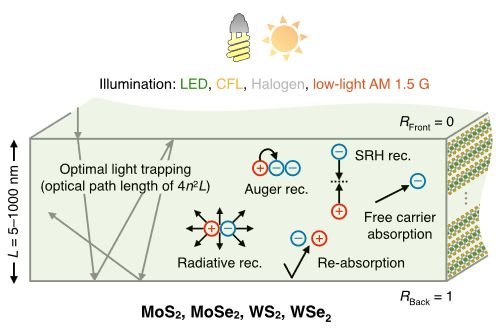New research by Stanford University has investigated the performance limits of transition metal Dichalcogenide solar cells for indoor energy harvests intended for feeding the internet of things (IoT) devices and sensors. The analysis showed that these cells can achieve a power conversion -efficiency of up to 36.5%.
A group of researchers from Stanford University has the potential of Transitional metal Dichalcogenide (TMD) solar cells for light harvest in indoor environments and has discovered that these devices offer the highest potential compared to other cell technologies.
TMDs are two -dimensional materials with remarkable semiconducting properties and high optical absorption coefferfiCients. This makes them suitable for the production of semi-transparent and flexible solar cells with potential applications in space travel, architecture, electric vehicles and portable electronics, where lightweight, a high power-per-weight ratio and flexibility are very desirable.
“Our work evaluates the potential of transition TMD sun cells for feeding indoor IoT devices,” said the corresponding author of the research, Frederick Nitta, said PV -Magazine. “It shows that TMD sun cells can perform better than commercial indoor photo -photovoltaïschens under different lighting conditions. Our study emphasizes that improving material quality and optimizing designs is crucial for unlocking higher efficiency. In general, TMD sun cells can offer a practical, sustainable Energie -Ecosyting for the Energie -Ecosyting.”
“Transition metal Dichalcogenids are layered materials such as WSE2 and MOS2, which have a high optical absorption, have good tire distance and quickly become ‘good enough’ for such applications, even with a few still present defects,” co-author Eric Pop added. “We have looked at their fundamental performance limits with the help of a realistic detailed balance model with measured optical properties and various recombination mechanisms, including defects. In most cases, even with materials available today, the TMD thickness to maximize the performance of the solar cell is only 20 to 30 Nm.”
In the newspaper “Transitional metal Dichalcogenide solar cells for the interior of domestic energy“Published in DeviceThe research team considered Solar cells with one junction made from TMD materials such as Molybdendendisulfide (MOS2), Molybdenen Diselenide (Mose2), Wolfraam Disulfide (WS2) and Tungsten Diselenide (WSE2) with different material qualities and under different indoor lighting conditions.
The scientists used a balance model with measured optical properties, as well as radiation, auger and shockley-read-hall (SRH) recombination, as well as various indoor light sources, including compact fluorescent lamp (CFL), light-emittering diode (LED) and low intensity AM light.
“We believe that TMD sun cells can perform better on existing indoor PV technologies, with power reversal efficiency limits up to 36.5% under fluorescent, 35.6% below LED, 11.2% under halogen and 27.6% under low light AM 1.5 g of lighting at 500 Lux,” the scientists said. “With current material quality, TMD sun cells can reach up to 23.5% under fluorescent, 23.5% below LED, 5.9% under halogen and 16.3% under low light am 1.5 g lighting at 500 lux.”
They concluded that TMD PV devices have the potential to surpass other commercial indoor photovoltaic technologies. “Future work will have to concentrate on further refining the electrical and optical designs of TMD sun cells to fully benefit from their highly efficient potential and to adjust them for broader commercial applications,” they said.
This content is protected by copyright and may not be reused. If you want to work with us and reuse part of our content, please contact: editors@pv-magazine.com.

